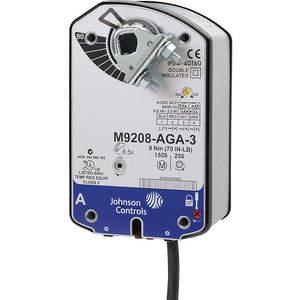Johnson Controls M9208-BGC-3 electric actuator is used in HVAC and building automation systems to control the opening and closing of air dampers for regulating airflow and temperature. With its precise and responsive movement, it ensures efficient heating, cooling and ventilation.
Features:
- It is integrated with spring return functionality for fail-safe operation.
- This electric actuator has a self-centering clamping shaft design for precise control.
- It offers a 90 degree stroke, enhancing versatility in control.
- This Johnson Controls M9208-BGC-3 actuator features two single pole double throw switches for enhanced control options.
- It comes with cable connections for easy setup and facilitates simple on / off signal transmission for quick response.
- This actuator offers motor rotation in both clockwise and counterclockwise directions.
- It is equipped with an anti-rotation bracket for secure installation.
Frequently Asked Questions:
Q. How to install Johnson Controls M9208-BGC-3 electric actuator?
A.
- Mount actuator securely on the valve or damper.
- Connect appropriate power supply and control signals.
- Ensure actuator and valve/damper shafts align.
- Connect and verify any position feedback.
- Energise the actuator and test its operation.
- Adjust settings for optimal performance if needed.
Q. How do I clean and maintain this electric actuator?
A.
- Turn off power supply to the actuator for safety.
- Gently wipe exterior surfaces to remove dust and debris.
- Apply recommended lubricant to moving parts if necessary.
- Inspect electrical connections for any loose or damaged wires.
- If present, clean and ensure proper functioning.
- Regularly check for signs of wear, corrosion, or damage.
- Consult manufacturer guidelines for more extensive maintenance.
- Ensure the actuator's enclosure is properly closed and sealed.
Q. What is the difference between an electric actuator and a mechanical actuator?
A. Electric actuators are powered by electricity and offer automated, precise control through signals. They suit applications requiring accuracy and remote operation. Mechanical actuators rely on manual force for operation, lacking automation and precision. They find use in simpler applications without requiring automation.




